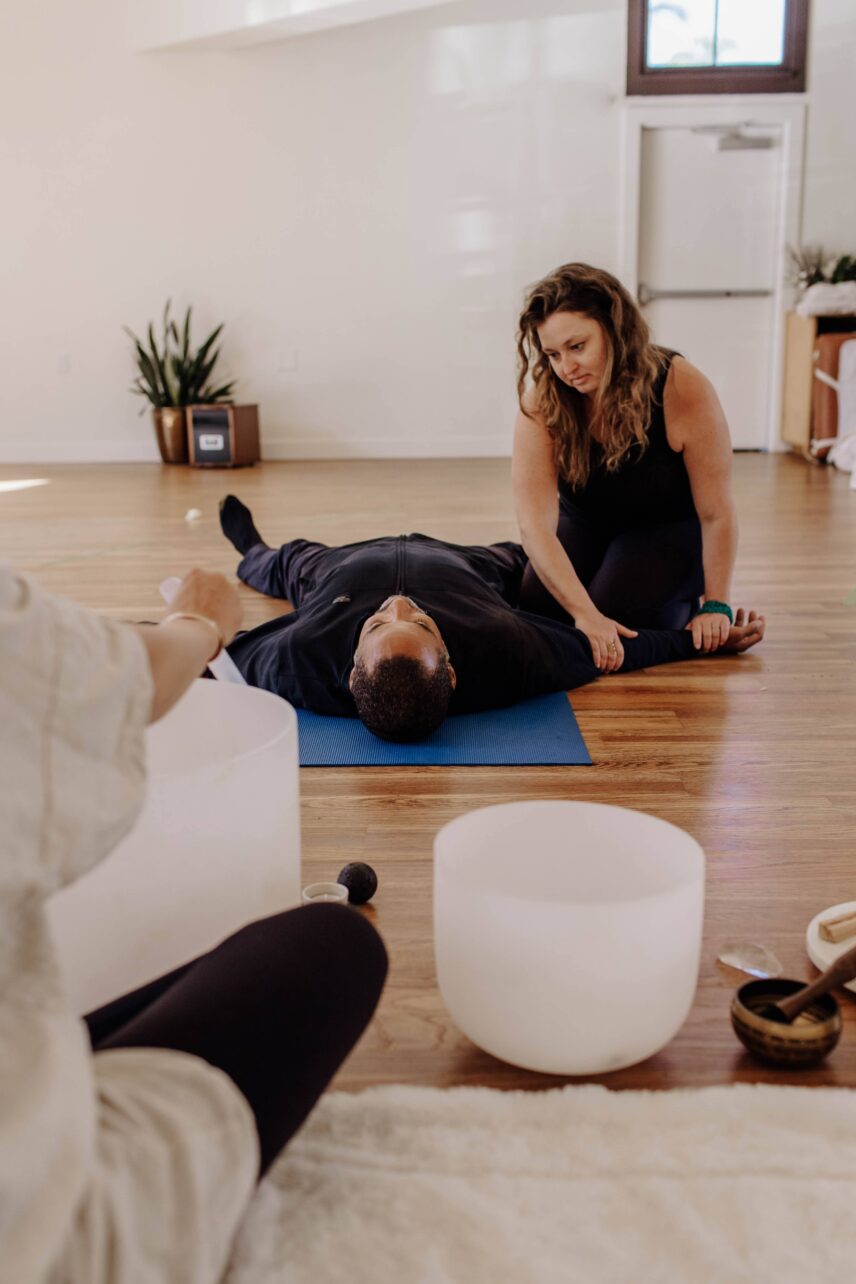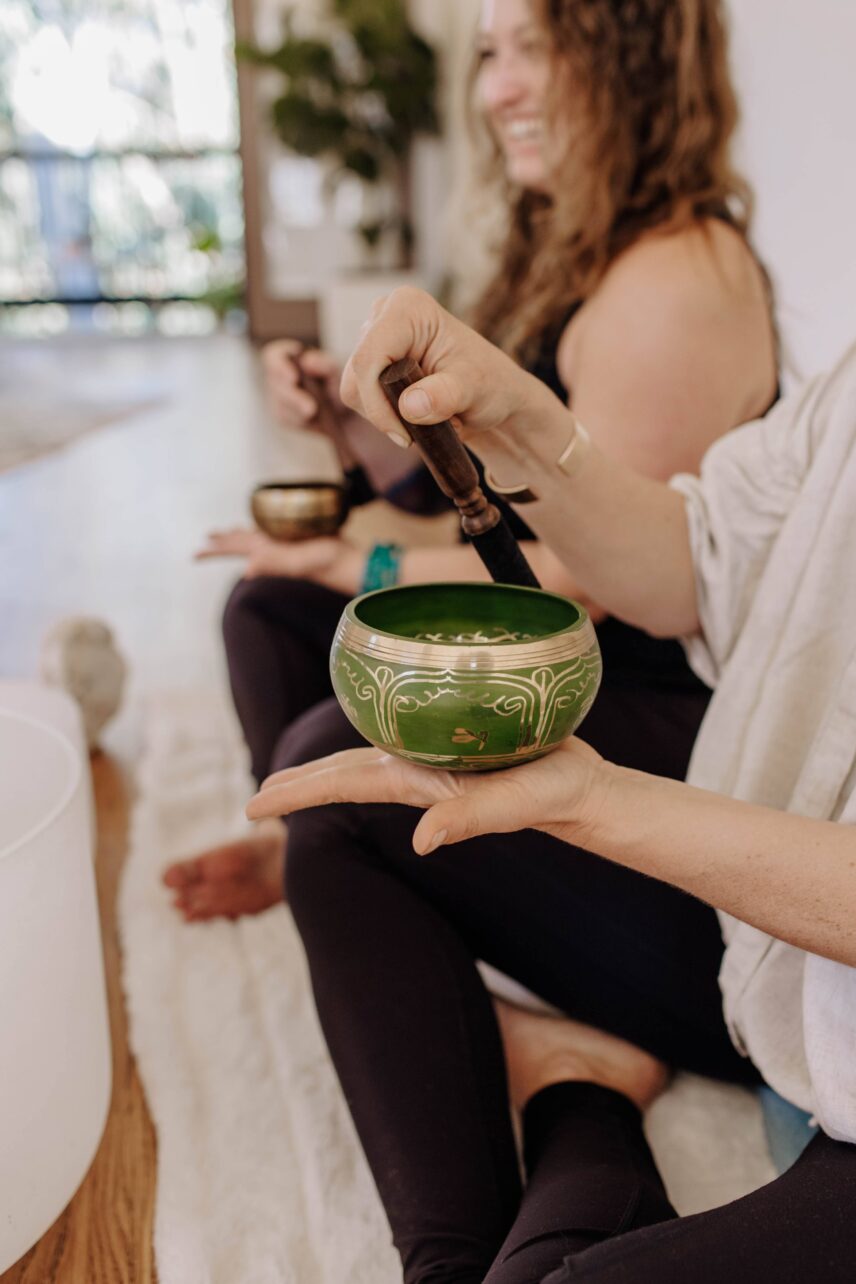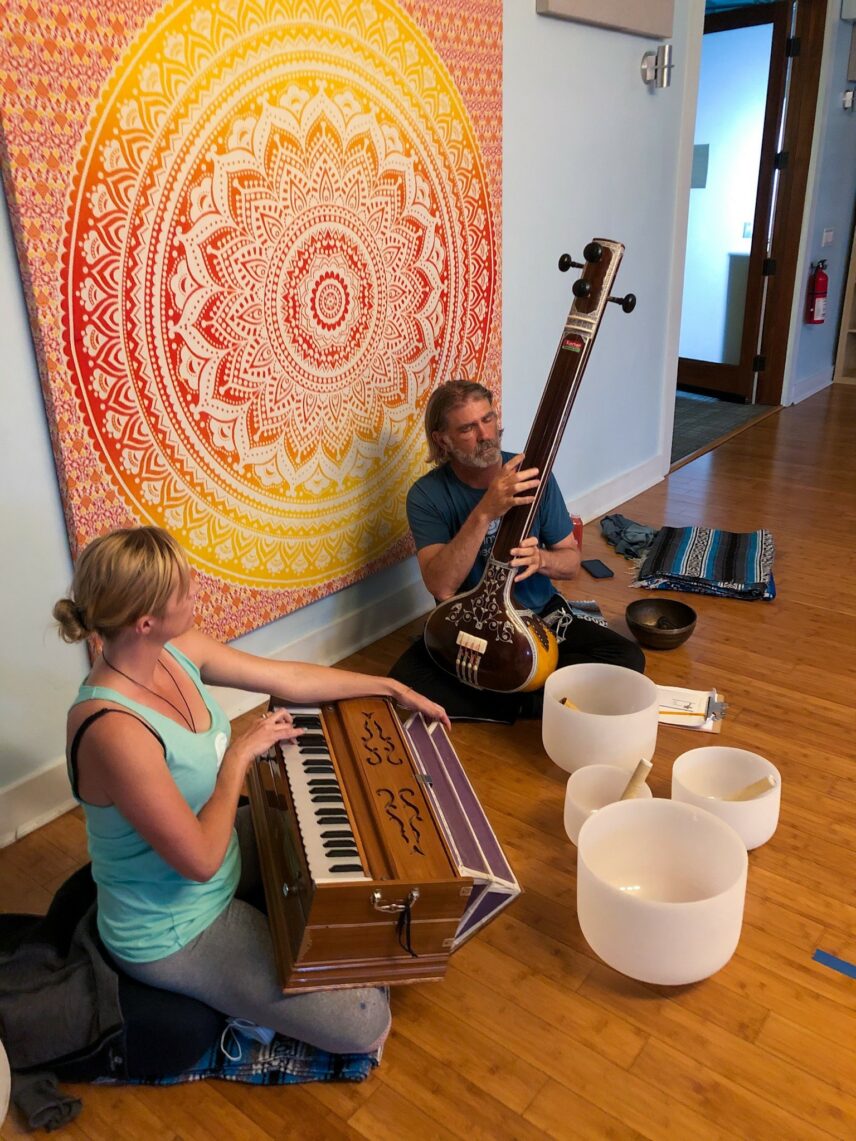Article begins
Striking a drum, shaking chimes, circling a crystal bowl’s rim: these actions release sonic energy. In the US retail Yoga arena and beyond, enthusiasts use sound wave energy in sound bath events—meditative percussive immersions that surround bathers with the hum and tinkle of productive vibrations. As health researchers like Tamara Goldsby and colleagues confirm, when leveraged with care, sonic forces positively affect mood and well-being.
Amid the chime and drone of bowl and gong, sound bath afficionados deploy popular understandings of physics and the body to claim the practice’s calming, therapeutic effect. Yet their scientistic and spiritualized framings look past higher-order sociopolitical determinants of stressed-out tired minds and bodies. In its surging popularity and commodification, the sound bath’s radical resonance is diminished, its potential for socially impactful healing stilled in favor of its utility for individualized respite care.

Sound energy, life force
A postural Yoga class nears its end. Lights dimmed, participants take up the typical final pose: savasana (lying prone and still to “process” or “receive the benefits” of the practice). Any other day the room might lapse into near silence, scuffs of prior movements and rhythmic breathing replaced by ambient noise or new age music streaming softly.
But today, the teacher, aided by a colleague, releases various tones and vibrations from crystal bowls, chimes, a rain stick, a gong—instruments that, when struck by a felt-tip mallet, stroked in a swirl, shaken, or otherwise animated, emit streams of sonic energy. Now and then, one teacher’s voice gently and concisely explains that we are hearing a specific note, thought to be related to this or that chakra (embodied energy reservoir). The other taps a tuning fork and slowly moves around the room dipping, lifting, and rotating the buzzing tool, its resonance shape-shifting for each client in the process. The waves of sound washing over and through us are meant to intensify or deepen savasana-induced relaxation.
This particular exposure of measured bongs, slow rattles, and ringing pulses is just a taster (see also below); dedicated sound baths typically last about an hour. And the teachers suggest that the vibrational energy of the instruments in a dedicated sound bath (which the studio is about to begin offering regularly) could “remove energetic blockages,” “regulate our nervous systems,” and otherwise “shift” our “vibrations” back into good working order. Indeed, research shows that carefully executed sound bath treatments using singing bowls are notably therapeutic.
Sound baths are a variant of a practice called energy healing, in which universal or human energies are deployed, manipulated, enhanced, redirected, balanced, and so on, often via a laying on of hands. Technically, two classes of energy exist: potential or stored energy (e.g., chemical, mechanical, nuclear, gravitational), and kinetic or moving energy (e.g., electrical, radiant, thermal, motion, electrical). Sound is energy on the move through substances (e.g., air, water) in waves. Sound energy is released when an object or substance is forced (e.g., through percussion) into a vibrating state.
The science of sound medicine is in its infancy. But as physics experts know, sound waves coming from one object can induce other objects to vibrate when those objects are sensitive to the same frequency. This phenomenon—sympathetic vibration or sympathetic resonance—explains how one tuning fork leads a similar tuning fork across the room to vibrate without direct physical contact.
Empirical observations such as this, or regarding other material effects that vibrations can have, plus people’s experience of the emotional impact of music and of the spoken word, have no doubt fueled sound’s cross-culturally common reputation as an empowered force that can, for example, bring people into trances.
Sound can even be experienced as life generating. Many traditions hold that sound played a major role in the world’s creation. For instance, in the Judeo-Christian tradition, Genesis 1.2–1.3 tells us, “[T]he Spirit of God moved upon the face of the waters. And God said, Let there be light.” A Japanese creation story has sound begetting light and bringing order out of chaos. Even J. R. R. Tolkien’s fictional Middle Earth was acoustically driven, according to the origin myth he wrote for it.
In Hindu scripture (and in Yoga philosophy) “Om” is the primordial sound—the original generative vibration. Om, better represented as Aum, is one of six bija or “seed” sounds—single-syllable nonwords (Lam, Vam, Ram, Yam, Ham, Aum), each of which is said to have a particular vibratory frequency. Chanting or repeating a bija can therefore have certain vitalizing effects.
Sound baths leverage the connections that can be drawn between sound energy and vitality. And although sound baths built around such ideas have likely existed for eons, widespread interest is now burgeoning.

Tracing the trend
Many volunteers in a multi-methods sound bath study that I initiated in late 2022 in San Diego are relative newcomers to sound bathing. One in four undertook their first sound bath in 2020 or later. But, excluding three enthusiasts who began in the late 1990s, the typical first bath occurred in 2016. The start date trend line represents a long shallow incline with a subsequently steep upward curve.
Similarly, media coverage indicates an interest surge beginning in 2015 in neighboring Los Angeles. Some attribute this to the popularity of mid-century architecture at the time, pointing to the Integratron, a domed structure designed in the mid-1950s (ostensibly with input from extraterrestrials) to serve as “an electrostatic generator for the purpose of rejuvenation and time travel.” As the twenty-first century unfolded, sound baths using crystal bowls displaced UFO-focused events as a central Integratron activity, and those interested in the building would have thereby also learned about the practice.
Maybe so. But the structure’s proximity to the site of the trendsetting Coachella Valley Music and Arts Festival provides a more convincing explanation regarding how the Integratron’s offerings became better known. And there is the sound bath’s connection to Yoga.
Yoga, named for a Sanskrit term meaning to yoke or harness, originated in India several thousand years ago. Initially, Yoga comprised mostly meditative and ascetic practices geared toward spiritual liberation or the experience of one’s unification with universal forces. Yoga’s translation thereby now includes to integrate or unify; in some Yogic traditions (there are many), Yoga means discipline.
Much Yoga today, particularly in the United States, entails regularized postural practices undertaken in class formats, in shop-front settings, for a fee. As anthropologists Alison Shaw and Esra Kaytaz describe it, modern postural yoga (often linked to the Hatha tradition) is in part the hybrid result of India’s colonization, during which time enthusiasts recast Yoga as both “India’s spiritual gift to the materialistic west” and a masculinized, individualized, domesticated, and deracinated bodybuilding regimen reflecting then-popular nationalistic European physical fitness ideals. Rather than being ages old, the sun salutation sequences now characteristic of retail Yoga classes were popularized in the 1930s and 1940s as a nation-building tool.
Even when offered in US retail settings, Yoga’s link to well-being has not been forgotten: the Centers for Disease Control and Prevention reports that Yoga is the most commonly reported alternative health system in the United States. An analysis of 1999–2006 National Health and Nutrition Examination Survey (NHANES) data demonstrated associations between Yoga and favorable health outcomes, such as lower odds of obesity and of high blood sugar. Such findings persist, and there is also clinical evidence for positive mental health outcomes.
Yoga now holds a notably lucrative corner in the US wellness economy. Its popularity showed some signs of ebbing just before COVID-19 appeared but, aided perhaps by a rapid pivot to online teaching during the height of the pandemic, the market for Yoga is presently growing by about 10 percent each year. Combined with the rise of add-on workshops and events attuned to self-care, which many consumers now see as an essential practice, this context seems to have catalyzed a global sound bath boom—at least for those with the means to participate.
Bathing in sound
As the street-side lobby door closes, city noise recedes. Intentionally low lights cultivate restfulness and interiority; greenery, a small, pebbled fountain, and natural wood cubbies for shoes suggest tranquility. In the studio, candles flicker and essential oils are diffusing.
Parvati, our host, wears yoga clothing and a loose kimono in neutral tones. Today’s tools have been set out on a blanket. They and the gong behind it—and flowers, crystals, and talismans encircling this ersatz stage—form the wood-floored studio’s focal point. When seated behind or within the array, Parvati can easily reach not only her hand-held tuning forks and chimes but also the not-so-portable gong and crystal bowls that provide her offering’s core vibrations.
Silence dominates as clients arrive, roll out the yoga mats on which they will recline, and arrange borrowed bolsters, blocks, and blankets for maximum support and comfort. Parvati speaks in low tones to an individual new to the practice, helping him get set up. Here and generally, unlike at a sound bath my team observed at a busy, mainstream fitness franchise, the ambiance is intimate and calm. And money is not mentioned; spots were reserved online ahead of time, via an “offering” of $25. This is the typical euphemism; but some providers call fees an “investment” and one, so far, termed payment an “energy exchange.”
After three chimes signaling the beginning, our leader explains her vibrational intent, which in this case is to break down and help us to release stagnant energies in and around our sacral chakras so that our creativity can flow freely. We are led in a “centering” or “grounding” exercise involving slow, deep breathing from a seated position, concurrent to emptying our minds and bringing our focus into the here and now. At times Parvati will walk around softly to deliver or distribute sound with her hand-held chimes, but she starts and finishes her baths at this spot.
Some sound baths—particularly longer ones—can be paired with other treatments such as Reiki, which involves laying on of hands for energy transfer. Some include instruction in the gentlest of yoga poses, extended breathwork or breathing exercises, or various other (low energy) activities such as prompted journaling or acupressure or blessing and sharing a ceremonial beverage. Yet, despite the concerted nature of such activities, sound bath events are intensely personal.
With some exceptions, the atmosphere is reverent and the vow of silence implicit. “Gaze is inward,” as is the experience. Looking is not part of the script. Debriefing afterward is also not typical, but providers and receivers generally cast sound bath events as deeply relaxing if not therapeutic or healing. Some speak directly of the “trauma” clients carry with them, which sonic energy might help to dissolve and dissipate; accordingly, clients may experience an array of emotions, thoughts, and feelings. Some providers do therefore issue trigger warnings—the impact of which I shall explore elsewhere.
What’s shaking?
One might have expected interviewees to point to ancient Yoga texts and traditions to explain how sound baths work. But in conversations and observations so far, people instead use an admixture of personal understandings regarding how bodies and sound work that follow particular patterns.
Many start by stating that everything vibrates. Those with more exposure continue, by identifying concordances, such as between vibrational energy and the pulsations animating our embodied experience (e.g., in our arteries and veins, in our breathing). Anatomical predispositions are also identified. One long-term enthusiast told me that the crystal bowls communicate vibrationally with matching crystals that exist atop our pineal gland. In other words, our bodies are cast as inherently susceptible, anatomically, to vibrational energies. (In my prior research on cannabis, people likewise pointed to the body’s endocannabinoid system, a network of receptors which regulates many of our critical bodily functions, as proof that we are meant to imbibe.)
Physiologically, according to common understandings, sound baths trigger what many enthusiasts call a “relaxation response” so that our bodies and minds can begin to deeply “rest and digest.” The binary alternative to this would be to experience “fight or flight,” which happens, as sound bath devotees explained, when “the nervous system is dysregulated.” Some also say that vibrational energy “massages the vagus nerve.”
Many felt the effects of the bath as “buzzing” or “humming” energy traveling through the body: “The sound came off of the instrument, and it traveled in its wave. And it traveled to me and became part of me,” observed sound bath participant Elena, adding “everything is connected.” Raul, also a receiver, experienced sound “three-dimensionally” and sensed that he was “floating.”
Although experienced internally, individually, the environment did matter. Interviewees frequently mentioned the provider’s “intention,” or their aim in holding the session, which could affect outcomes, for instance by turning what should be a healing event into a “performance,” or by injecting negative energy—although very few reported experiencing this themselves. Some people, providers particularly, took account of the broader energetic field: “If a whole group of people are coming into a room, then we have many electromagnetic fields interacting with one another, which also contributes to the experience,” noted practitioner Nadine.
Beyond “biofields” some participants spoke of “brainwave entrainment” as well as of “clearing” the chakras or of “recalibrating,” or “resetting” these energy centers or one’s organs, or even emotions, to preferred frequencies. “You’re kind of fine-tuning yourself,” said recipient Judy.
With few exceptions so far, the scientistic aspects of people’s explanations are not explicitly counterfactual (e.g., those biofields and pineal crystals do exist). But lay understandings of processes and structures differ in important ways from those held by scientific researchers. Most obviously, participant discourse regarding problems with “the vagus nerve” suggests an epidemic of vagal perturbation. Biomedically speaking, this is not the case. The apparent repurposing and expanded application of clinical concepts like dysregulation merits attention.

Self-investment versus social change
Perhaps not coincidentally, the sound bath boom coincides with increased consumer interest in “self-care”—a phrase that in some contexts could be exchanged with self-distraction. Sometimes the care indexed is palliative at best, serving in the long run to perpetuate the status quo by fostering disregard for the social determinants of ill health or poor well-being. Justifying one’s self-care with reference to the “reset” it offers may be a sign of such self-distraction.
The phrase self-care has a long history of usage by civil rights and feminist activists to describe radical acts to aid in the survival of Americans oppressed by racism and sexism. But it was originally a medical concept, explains journalist Aisha Harris. Its justifiably politicized use in the fight against the white supremacist, patriarchal, capitalist status quo and recent efforts to reclaim radical self-care notwithstanding, the term’s deployment in later twentieth-century healthcare indexed first the involvement of patients in their own care management and next a hand-off of responsibility for health from clinician to patient.
Appropriated by other market sectors in the new millennium, it came to describe a wellness-centered but highly individualistic, consumption-based mode of self-investment. This theme is replicated literally in sound bath advertising when the cost of attending is termed an “investment”; although it may also be termed an “offering”—and in two instances so far, I have seen it called an “energy exchange.”
The call for rejuvenation associated with self-care through sound baths does resonate with the right to rest manifesto, articulated by artist and theologian Tricia Hersey as resistance to the legacy of plantation-based slavery in which bodies—Black bodies in particular but all bodies under capitalism—are treated as machines. Our political economy rests on bodies not resting, and on controlling—regulating—the human resources that fuel it. Against this backdrop, making time for self-care and reclaiming one’s Right to Rest could be a radical action.
That said, capitalist culture’s fetishization of productivity subverts this kind of intervention. Even leisure activities must be justified with reference to how they reenergize us, enabling further work. Sound baths are said to render participants more balanced or to massage jangling nerves so we can better cope with busy lives.
Not by accident, then, one of the first sound baths I experienced was structured around “fill your cup” rhetoric, which overtly promotes the productivity ideal. Doing nothing, and for no reason—sitting back and relaxing for the joy of it versus because it will help you to be more or do more—gets no mention in sound bath narratives gathered so far. This despite the prevalence in retail Yoga sessions of the phrase, “You are enough.”
Talking about herself and other devotees, and using examples relating to corporate greed, Anna explained that “We’re in postcapitalism right? [Everyone] has been betrayed.” But common understandings and explanations surrounding sound baths emphasized individual factors. Rather than working to change the system, most people simply accepted the busyness and sense of disconnection infusing current life. Sound baths, they said, help offset our individualized inabilities to sustain productive lives without becoming so unbalanced that reregulation is required.
But even Anna, who spoke of “major disillusionment,” held individuals accountable for “selling our souls and our bodies to Corporate America.” The fix entailed conservative individual versus radical communal action. Why? Culture: “America is still a highly individualistic society. So we’re always going to have that element of like having less community and more, I don’t want to say navel-gazing, but like individualism.”
The focus on the self in self-care seems endemic to—and is naturalized by—dominative mainstream American culture. Contemporary sound bath subculture seems synchronized to, or works in sympathetic energetic resonance with, current capitalism’s structural and cultural underpinnings, diffusing the radical potential of vibration-based care to spur social change. How to transform the beneficial energies created through self-care so that they power community care thus remains an open question.
In the meantime, the capacity of properly handled sonic forces for boosting individual well-being deserves continued investigation. Recycling terms from anatomy, physiology, and sound energy science to create socially acceptable explanations for what sound baths do and how they do it reinforces a tendency for distracting ourselves from the possibility of fixing what truly ails us. This form of “spiritual bypassing” leaves the causes of client malaise unaddressed, ensuring a steady flow of repeat customers aiming to relax, reset, and recharge.

Recharged and readied for reentry
Bowls have been tapped and swirled, gently and then with some force to stimulate the throat chakra. Strong gong vibrations have marched through reclined patrons in closely spaced beats, breaking up blockages, encouraging their release. Now, Koshi wind chimes tinkle from different parts of the room as the facilitator pads soundlessly among the clients. Her voice begins to rise, beckoning everyone softly back to their bodies, this world, this life. She invites people to attend to their breath, then to twinkle some mindful movement into their fingers and toes. After a full-body stretch, clients gather knees to chests. One by one, people roll over into a fetal position, resting then rising to sit, heads still bowed.
The session ends as it began, with chanting in unison: Ong Namo Guru Dev Namo (I bow to the divine teacher within). Hands at hearts, as a final rite, patrons are invited to breathe together and repeat three times communally Sat Nam (roughly, I am truth).
Now, silence. Many seconds tick by before the first softly sounded thank you. A few more follow, along with a quiet namaste.
Hushed and reverent, clients roll up mats, slip on shoes, and drift out of the studio. A mother and her visiting daughter chat softly with the teacher. Two regulars exchange quiet niceties. Most patrons exit as they entered, shouldering their gear and alone, dispersing into the city’s busy soundscape and back to their productive lives.
Author note: For the present, ethics board approved project, research assistants Summirlyn Harrington and Micah Sakado assisted with data collection; undergraduates Ace Boyle, Amara Golden, Ava Gulson, Emma Fitzpatrick, and Gabriela Lee helped prepare data for analysis. Data included ethnographically informed interviews and participant-observation at multiple sound bath events. In addition, Elisa Sobo completed several sound bath provider and related trainings. At the time of this writing, we had interviewed 19 providers (including nine who were men) and 20 receivers (four men). About half (less among providers, more among receivers) were White.

